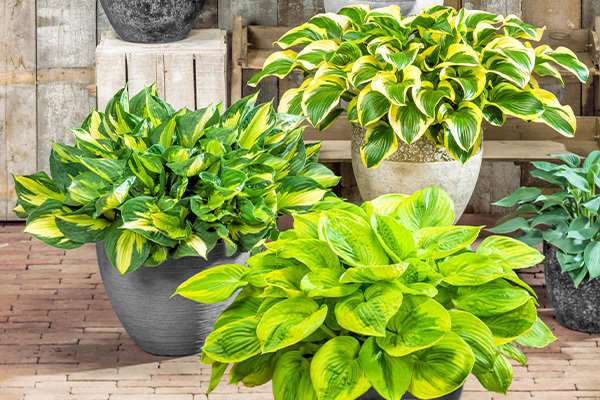
What We've Included
When to Plant | How to Plant | Where to Plant | When to Water | How to Feed | Overwintering | Deadheading | Propagating | Common Issues & How to Solve Them | When do they Flower?
When to Plant
Hostas can be planted at any time of the year! However, it’s best to avoid planting them in mid-summer when it’s incredibly warm and the soil is dry.

How to Plant Hostas in Borders and Containers
Loose roots to beginners might sound intimidating but are in fact, incredibly easy to plant and very budget-friendly. Here’s how to do it:
- Soak roots in a bucket of water for 1-2 hours before planting.
- Dig a hole in the border that’s big enough to house the root system. If planting in pots, fill it halfway with potting soil and then pop the roots in with the crown pointing upwards and the root system pointing to the floor.
- Plant in groups for a fuller display, usually in groups of 3, somewhere that gets plenty of sunlight.
- Ensure the crown is just below the soil unless the plant has some leaves, in which case leave them exposed with the rest of the root system under the soil.
- Water well once planted.
Where to Plant
Grow Hostas in moist soil and in partial shade. They are happy in borders or containers, as long as their soil is not too dry. If you are worried about dry soil, then pick a Hosta that has thicker and waxier leaves as they can be more tolerant to drought. They love fertile soil that’s heavy on clay and full of compost or well-rotted manure.
When to Water
Once they’ve established, hostas won’t need much watering. This may differ, however, in periods of drought. Plants in containers will also need more water as they drain faster. You can tell if your Hosta has dried up as its leaves will start to brown around the edges.

How to Feed
Hostas grown in borders need just fertile soil and perhaps an annual mulch to thrive. This mulch can be either garden compost or well-rotted manure. If your soil is less than ideal, adding a general-purpose fertiliser will help them grow to their full potential.
Hostas grown in containers will prefer a liquid feed once a month while it’s in full growth. You can use a general-purpose liquid feed for this.
Overwintering
Hostas, like many perennials, will die back in late autumn and over winter. They will become dormant until spring. However, new leaves that emerge in early spring can get damaged by frost. Protect the plant with a few layers of horticultural fleece if frost is in the forecast.
Deadheading
You can leave flowers to die back naturally if you wish. However, if you prefer a tidy display, then spent blooms can be removed. This will also stop the plant from wasting its energy on seed production.

Propagating
You can propagate Hostas by division. This can be done in autumn or spring, preferably once they’ve finished flowering if you choose to divide them in autumn. The division helps to decongest large clumps that have gotten a bit too wild over a few years of growth. To divide, lift them out of the ground gently, trying not to damage the roots, and split clumps with a sharp knife.
It’s advised that divided plants should be replanted directly outside. If that’s not possible, then you can pot them up and keep them indoors until the danger of frost has passed. Just ensure that they’re planted at the same depth as they were before you dug them up.
Common Issues & How to Solve Them
Hosta's biggest foes are slugs and snails. They especially love young plants, attacking them while they’re small and vulnerable. To mitigate this, you can do the following:
- Pick slugs and snails in the evening, as this is when they are most active.
- Wrap copper bands around the base of the plants or around the pot they’re in.
- Mulch the topsoil with horticultural grit.
- Slug pellets can also be used, but we recommend this as a last resort. Ensure the pellet’s active ingredient is ferric phosphate, as others are incredibly toxic to wildlife, pets, and other animals.
When do they Flower?
Hostas produce flowers anytime between July and August. Their foliage will last from mid-spring until late autumn, providing months of interest to your garden.

